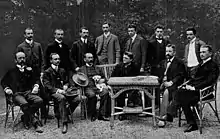Cornelio August Severinus Doelter
Cornelio August Severinus Doelter, Doelter y Cisterich or Cisterich y de la Torre (16 September 1850 – 8 August 1930) was a Caribbean born Austrian geologist who specialized in chemical mineralogy and petrology, serving as a professor at the Universities of Graz and Vienna. He conducted pioneering experiments in synthetic mineralogy and petrology by melting down rocks and allowing recrystallization of mineral constituents.

Life and work
Doelter was born in Arroyo, Puerto Rico, where his father Carl August managed sugar and coffee plantations that originally belonging to his wife Francisca Maria de Cisterich y de la Torre. His mother was Spanish and his name was originally given as Doelter y Cisterich. The family moved to Karlsruhe in 1855 where Doelter studied at the Lyceum from 1860. From 1865 he studied at the Lycée St. Louis and the Lycée Bonaparte before joining the École Centrale des Arts et Manufactures in 1869. The next year he moved to the University of Freiburg and then Heidelberg. He was influenced by his teachers Robert Bunsen, Johann Friedrich Carl Klein, Ernst Wilhelm Benecke. He received a doctorate in 1872 and then worked with Eduard Suess, Ferdinand von Hochstetter, and Carl Hauer. He joined the Austrian Geological Survey in 1873 and became a professor of mineralogy at the University of Graz in 1876, becoming rector in 1906. In 1907 he moved to the University of Vienna where he succeeded Gustav Tschermak. He worked there until his retirement in 1922.[1][2][3]
Doelter's work involved travel in the early years and was involved in a survey of the Pontine Islands (1874), Monte Ferro and Cape Verde (1880-1881), and he described his observations and experiences in his 1884 travelogue. His experimental work involved the synthesis of minerals at high pressure and temperature including nepheline, pyroxenes, micas, and zeolites.[4] He examined the effects of remelting and recrystallization and these went into his 1890 textbook on general mineral chemistry. He studied water of crystallization in the zeolites, examined the physical and chemical laws involved in silicate melting. He later examined the physical properties of silicates and other minerals and suggested theories to explain the nature of electrical conductivity by crystals. In 1906 he published a book Petrogenesis. He also looked at the fluorescences of minerals under radiation from Radium and ultraviolet.[5]
Doelter married Eleonore Fötterle in 1876 and they had a son and daughter. They separated in 1915 and he married Maria Theresia Schilgerius in 1919. He served as an editor for the Naturwissenschaftlicher Verein and was a curator of the Landesmuseum Johanneum.[3]
References
- S., L. J. (1930). "Prof. Cornelio Doelter". Nature. 126 (3182): 656–657. Bibcode:1930Natur.126R.656L. doi:10.1038/126656b0. ISSN 0028-0836. S2CID 35187623.
- "Doelter y Cisterich Corneliu". Österreichisches Biographisches Lexikon 1815–1950 ( (PDF) (in German). Vol. 1. Wien: Verlag der Österreichischen Akademie der Wissenschaften. 1957. p. 191.
- Fischer, Walther (1971). "Cornelio Doelter (1850—1930)" (PDF). Mitteilungen der Abteilung für Mineralogie am Landesmuseum Joanneum (in German). 1–2: 1–37.
- Yoder, H. S. (1993). "Timetable of Petrology". Journal of Geological Education. 41 (5): 447–489. Bibcode:1993JGeoE..41..447Y. doi:10.5408/0022-1368-41.5.447. ISSN 0022-1368.
- Leitmeier, Hans (1959). "Doelter, Cornelio August". Neue Deutsche Biographie (in German). Vol. 4. pp. 25–26.
External links
- Mitteilungen des Naturwissenschaftlichen Vereines für Steiermark (1863)
- Über die Capverden nach dem Rio Grande und Futah-Djallon; Reiseskizzen aus Nord-West-Afrika (1884)
- Allgemeine chemische mineralogie (1890)
- Physikalisch-chemische mineralogie (1905)
- Petrogenesis (1906)
- Das radium und die farben; einwirkung des radiums und ultravioletter strahlen auf organische und anorganische stoffe sowie auf mineralien (1910)
- Handbuch der Mineralchemie (1912)